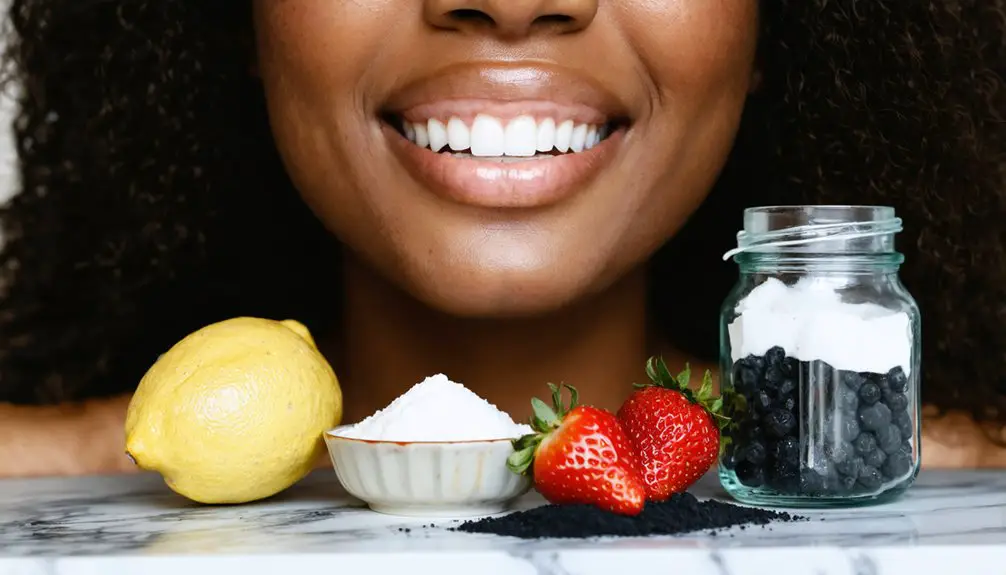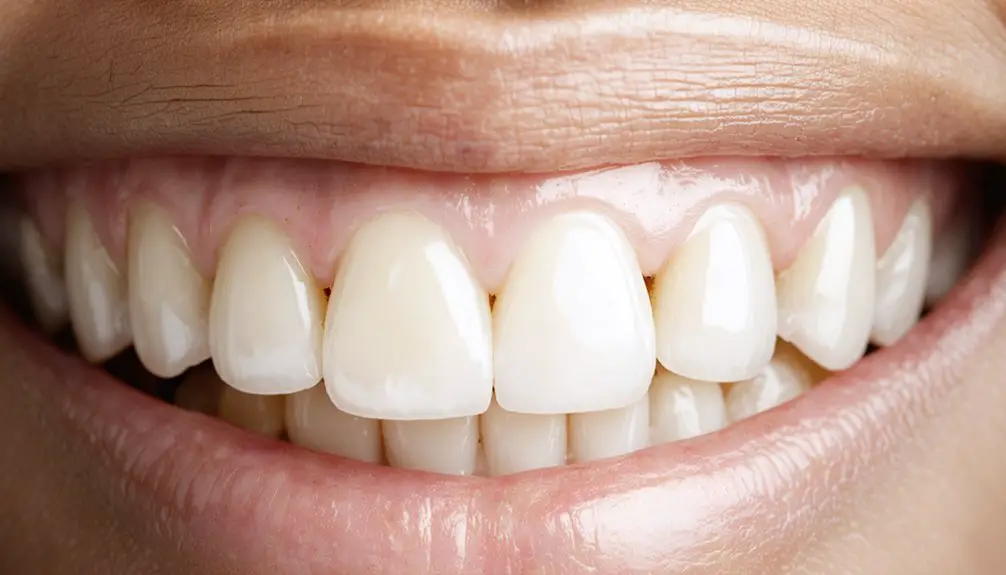You can effectively whiten your teeth at home using scientifically-supported methods that combine gentle abrasives with natural whitening agents. Mix baking soda with hydrogen peroxide for a safe whitening paste, or try oil pulling with coconut oil to reduce staining bacteria. Incorporate crunchy fruits and vegetables into your diet, and limit staining beverages like coffee and wine. Understanding the science behind these methods will help you achieve ideal, lasting results.
Key Takeaways
- Mix baking soda with water and apply gently twice weekly using a soft-bristled toothbrush to effectively remove surface stains.
- Create a whitening paste by combining hydrogen peroxide with baking soda for deeper stain removal and enhanced brightening effects.
- Practice oil pulling with coconut oil for 15-20 minutes daily to naturally draw out stains and reduce bacteria.
- Combine crushed strawberries with baking soda to utilize natural malic acid for breaking down tooth discoloration.
- Incorporate crunchy fruits and vegetables like apples and carrots into your diet to naturally clean teeth while stimulating saliva.
Understanding Natural Teeth Whitening Ingredients
The science of natural teeth whitening revolves around key ingredients that work through distinct mechanisms to remove stains and lighten tooth surfaces.
Baking soda and hydrogen peroxide form a powerful duo, with baking soda‘s mild abrasiveness lifting surface stains while peroxide oxidizes deeper pigments. Oil pulling with coconut oil for 15-20 minutes daily can help draw out stains while promoting overall oral wellness. Creating a paste with 1 tsp of baking soda mixed with water provides an effective weekly treatment.
For those seeking natural whitening alternatives, activated charcoal‘s adsorption properties can bind to stains, though you’ll need gentle application to protect your enamel.
While fruit acids from strawberries and citrus show some ingredient effectiveness, they require cautious use due to potential enamel erosion.
Mineral-rich banana peels offer a gentler approach, providing essential elements like potassium and magnesium that may support enamel health while gradually reducing discoloration.
Understanding these ingredients’ mechanisms helps you choose the most suitable whitening method for your needs.
The Science Behind Safe DIY Whitening
While natural whitening ingredients offer varying degrees of effectiveness, understanding the scientific principles behind safe DIY whitening helps prevent potential damage to your teeth. Whitening safety depends largely on the active ingredients you choose and how you apply them.
Individual results vary based on your natural tooth color and type of staining. At-home teeth whitening products can effectively lighten teeth shades with consistent use. Hydrogen peroxide and carbamide peroxide, while effective, require careful attention to manufacturer guidelines to avoid enamel damage.
Peroxide concerns include potential cytotoxicity and enamel surface changes, especially at higher concentrations. You’ll minimize risks by consulting a dental professional before starting any whitening regimen, particularly if you have restorations.
Non-peroxide alternatives like bromelain show promising safety profiles with no cytotoxicity to human cells, though they may not whiten as dramatically.
Always follow recommended exposure times and discontinue use if sensitivity occurs.
Proven Home Remedies for Brighter Smiles
Several proven home remedies can effectively brighten your smile without resorting to expensive professional treatments.
For natural whitening, dilute apple cider vinegar with water for a one-minute rinse, but limit frequency to protect your enamel. You can also create a strawberry-baking soda paste, applying it once weekly to minimize acid exposure. Create a gentle whitening paste by mixing baking soda and peroxide for a safe, at-home treatment option.
Focus on enamel protection while pursuing whiter teeth by incorporating crunchy fruits and vegetables into your diet. These foods naturally clean teeth surfaces while stimulating saliva production. Oil pulling with coconut oil for 15-20 minutes daily can help remove surface stains naturally.
Complement these methods with enhanced oral hygiene practices, including twice-daily brushing with fluoride toothpaste and daily flossing. If you’re considering activated charcoal, use it sparingly as its abrasive nature may damage enamel with excessive use.
Remember to maintain regular dental cleanings for best results.
Best Kitchen Ingredients for Teeth Whitening
While baking soda‘s mild abrasive properties can effectively whiten teeth, you’ll need to limit applications to twice weekly and always mix it with water to prevent enamel damage.
You can enhance whitening results by combining crushed strawberries with baking soda, as their natural malic acid helps break down surface stains. Fresh pineapple contains powerful proteolytic enzymes that naturally dissolve surface stains on teeth.
If you’re considering activated charcoal, be aware that its effectiveness lacks scientific validation, and its abrasive nature could potentially damage tooth enamel if not used carefully. Consulting a professional dental evaluation before starting any whitening treatment will help ensure safer and more effective results.
Baking Soda Safety Tips
Although baking soda offers an accessible method for teeth whitening, its abrasive properties require careful consideration to prevent enamel damage. To protect your enamel health, don’t use baking soda more than a few times per week, and always mix it into a smooth paste with water to minimize abrasiveness. Use gentle strokes with a soft-bristled toothbrush.
Essential baking soda precautions include limiting application frequency and avoiding aggressive brushing. You’ll need to maintain regular fluoride toothpaste use since baking soda lacks cavity protection. Research shows that combining with toothpaste can enhance whitening effectiveness while maintaining dental safety. The alkaline nature of baking soda helps neutralize acidic substances that can stain teeth.
If you experience tooth sensitivity or gum irritation, discontinue use immediately. For safer alternatives, consider professionally formulated whitening toothpaste or consult your dentist about professional treatments, especially if you have pre-existing dental conditions or deep, intrinsic stains.
Strawberries As Whiteners
Despite their sweet taste, strawberries contain natural compounds that can help whiten teeth, primarily through malic acid‘s ability to break down surface stains. When you’re considering strawberry benefits for teeth whitening, you’ll find they offer a gentle, natural approach that’s less aggressive than commercial products.
To maximize whitening effectiveness, you can create a paste by mashing ripe strawberries with baking soda. Apply this mixture to your teeth for just a few minutes, but don’t overdo it.
While studies confirm strawberry extract’s whitening properties, the results are mild compared to other methods. You’ll need to be cautious about frequency, as the fruit’s acids can potentially harm your enamel.
Before starting any strawberry whitening routine, consult your dentist to verify it’s safe for your specific dental condition.
Activated Charcoal Benefits
The science behind activated charcoal‘s tooth-whitening capabilities reveals considerable limitations and potential risks. While you may see mild stain removal through its abrasive action, research shows its whitening efficacy falls considerably below traditional peroxide-based treatments.
You’ll want to exercise caution when considering activated charcoal for teeth whitening. Its high abrasiveness can damage your enamel, creating microcraters and surface roughness that may lead to long-term dental problems.
There’s also concern that it might interfere with fluoride effectiveness, potentially increasing your cavity risk.
If you’re determined to try it, consult your dentist first and use it sparingly. For safer alternatives, consider professional whitening treatments or over-the-counter peroxide-based products, which offer proven results without compromising your enamel’s integrity.
Daily Habits That Support Natural Whitening
You’ll notice significant whitening benefits by incorporating crunchy fruits and vegetables like apples, carrots, and celery into your diet, as these foods naturally scrub your teeth while you chew.
To maintain whiter teeth, you should limit your consumption of staining beverages such as coffee, tea, and red wine, which can deposit pigments onto your enamel.
When you do consume staining drinks, use a straw to minimize contact with your teeth, and rinse your mouth with water immediately afterward.
Eat Crunchy Fresh Foods
While many people seek expensive whitening treatments, incorporating crunchy fresh foods into your daily diet offers a natural and effective way to maintain whiter teeth. These crunchy snacks act as natural abrasives, physically removing surface stains and plaque during chewing.
When you eat foods like apples, carrots, and celery, you’re stimulating saliva production, which helps neutralize acids and fight bacteria that cause discoloration.
Replace sugary treats with nutrient-rich options like nuts and raw vegetables to enhance your oral hygiene routine. These foods provide essential vitamins and minerals that strengthen enamel while their fibrous textures massage your gums.
Combined with regular brushing and flossing, crunchy fresh foods help maintain professional whitening results longer and support overall dental health through their mechanical cleaning action.
Limit Stain-Causing Drinks
Maintaining brighter teeth requires more than just choosing the right foods – your beverage choices play an equally significant role in tooth color.
Stain causing beverages like coffee, tea, red wine, and sodas contain compounds that actively discolor teeth while weakening enamel through acid erosion.
To protect your smile while enjoying your favorite drinks:
- Use a straw when consuming acidic or pigmented beverages to minimize contact with teeth.
- Rinse your mouth with water immediately after drinking staining substances.
- Avoid combining acidic drinks with pigmented ones, as this accelerates staining.
- Limit frequency of consumption, especially of drinks containing chromogens and tannins.
Understanding these strategies helps you maintain whiter teeth while serving others professionally without compromising your own dental health.
Common Mistakes to Avoid in DIY Teeth Care
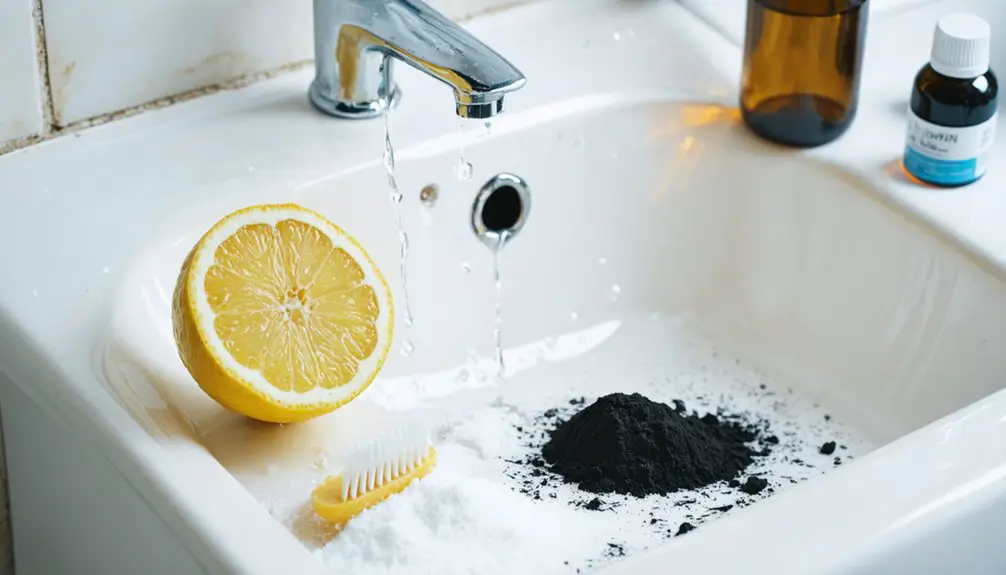
Despite the appeal of DIY teeth whitening, several common mistakes can compromise both safety and results.
Overusing products by leaving them on too long or applying them too frequently can damage your enamel and cause sensitivity.
Not preparing teeth properly through thorough brushing and flossing reduces whitening effectiveness and leads to uneven results.
Ignoring professional advice puts you at risk of selecting inappropriate treatments or missing underlying dental issues.
Rushing treatment by expecting instant results often leads to misuse and potential damage.
Finally, neglecting hygiene after whitening undermines your results – no whitening method substitutes for proper brushing, flossing, and dental visits.
To protect your oral health while achieving ideal results, follow product instructions carefully and maintain consistent dental care habits.
Combining Methods for Maximum Results
To maximize teeth whitening results, combining different treatment methods requires careful consideration of timing, product interactions, and safety protocols.
Scientific evidence shows that strategic combinations can enhance outcomes while minimizing sensitivity risks.
- Pair professional treatments with whitening toothpaste for maintenance, but avoid overlapping multiple bleaching systems simultaneously.
- Choose sensitivity-formulated toothpaste during intensive bleaching periods to reduce discomfort.
- Skip light activation during in-office procedures, as it doesn’t improve results but increases sensitivity.
- Allow recovery intervals between different whitening methods to protect enamel integrity.
For peak results, focus on evidence-based combinations like professional bleaching followed by maintenance with gentle whitening toothpaste.
This approach provides both immediate improvement and long-term color stability while preserving your dental health.
Time-Tested Traditional Whitening Solutions
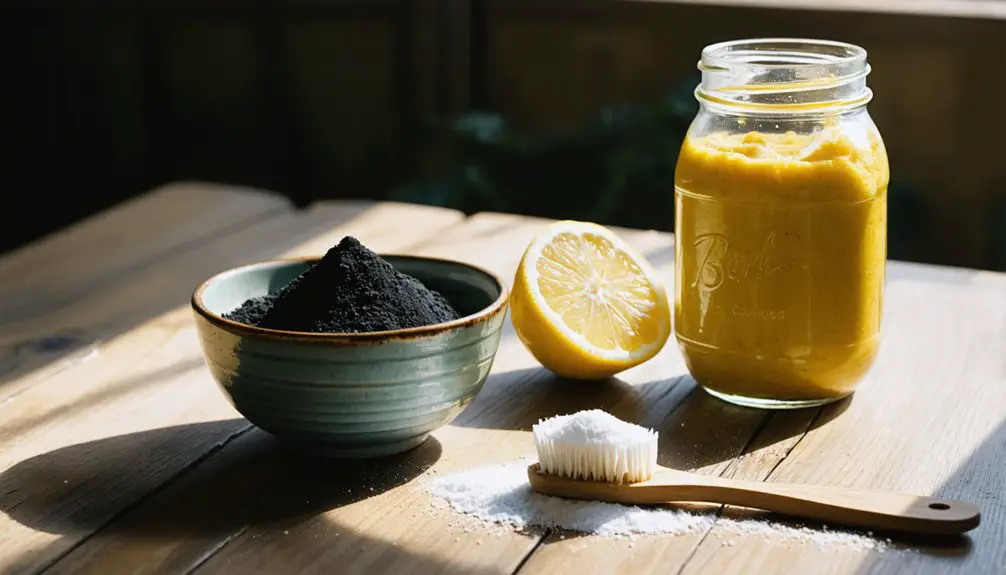
Throughout human history, traditional whitening solutions have demonstrated remarkable staying power, blending ancient wisdom with scientifically validated mechanisms of action.
From ancient Egyptian frankincense applications to African chewing sticks, these time-tested practices carry deep cultural significance while offering genuine oral health benefits.
Ancient wisdom meets modern dental health through traditional whitening methods that have served diverse cultures for generations.
You’ll find that baking soda’s gentle abrasive action and alkaline properties make it particularly effective for surface stain removal, while oil pulling with coconut oil can reduce bacteria that contribute to discoloration.
Traditional materials like activated charcoal and turmeric, when used cautiously, may help maintain whiter teeth through their unique chemical properties.
These ancient practices often combine mechanical cleaning with natural compounds that can break down stains or inhibit bacterial growth – providing a holistic approach to dental whitening that’s stood the test of time.
Maintaining Your Whitening Results
Your daily habits play the most essential role in preserving your teeth’s whitened appearance, with dietary choices and oral hygiene routines being particularly influential factors.
You’ll need to consistently avoid staining substances like coffee, tea, and red wine while maintaining proper brushing and flossing techniques to prevent new discoloration.
Daily Habits Matter Most
Three core daily habits form the foundation for maintaining whiter teeth: thorough oral hygiene, mindful dietary choices, and professional dental care. Your consistent efforts with daily brushing using whitening toothpaste, coupled with proper flossing techniques, create the baseline for lasting results.
Adding a whitening mouthwash to your routine enhances stain prevention.
- Brush twice daily for two minutes using fluoride-based whitening toothpaste
- Floss nightly to remove hidden debris between teeth
- Rinse with whitening mouthwash after meals
- Make strategic dietary adjustments by limiting staining beverages
Your lifestyle changes should include drinking through straws when consuming coffee or wine, increasing water intake, and incorporating natural tooth-cleansing foods.
Remember to wait 30 minutes after acidic foods before brushing, and maintain regular dental visits for professional oversight of your whitening maintenance.
Long-Term Prevention Tips
While daily habits establish a foundation for whiter teeth, maintaining long-term results demands a thorough prevention strategy.
You’ll need to manage both external and internal factors affecting your whitening durability. Control your exposure to staining agents by using straws for dark beverages and rinsing immediately after consuming potentially staining foods.
Monitor your whitening frequency carefully – excessive treatments can damage enamel. Focus on enamel care through proper nutrition, including calcium-rich foods and crunchy fruits that naturally clean teeth.
Schedule professional cleanings every six months to remove stubborn stains and receive expert guidance on maintenance. For touch-ups, use custom-fitted trays with carbamide peroxide gel as directed by your dentist, typically once every 6-12 months.
Remember that natural tooth color and age influence how long your results will last.
When to Choose Professional Help
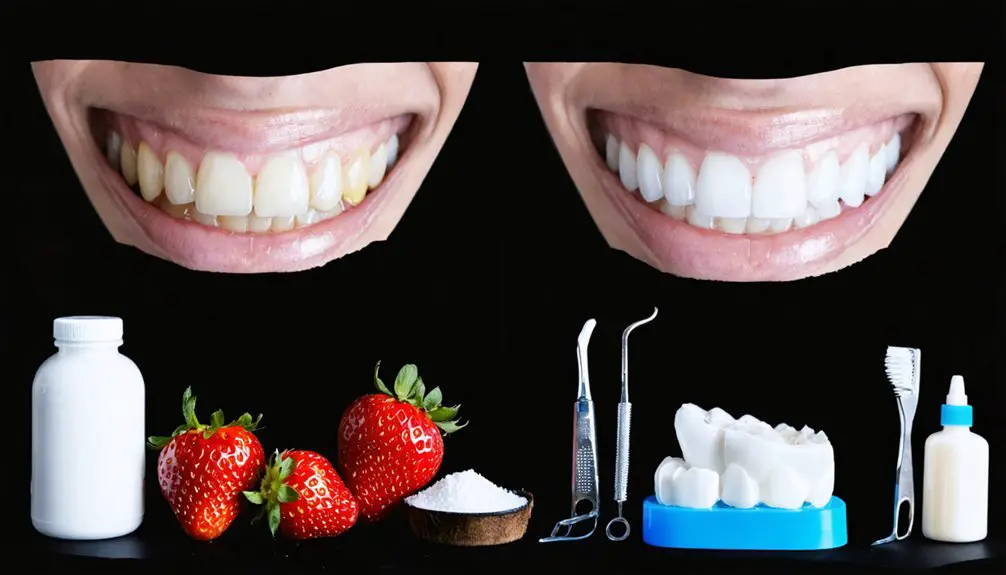
Despite the appeal of DIY teeth whitening methods, certain situations demand professional dental intervention for safe and effective results.
Professional whitening benefits include faster, more dramatic outcomes and specialized care for complex staining cases. A dental consultation importance can’t be overstated when you’re experiencing sensitivity or have existing dental work.
You’ll need to seek professional help if:
- You have significant tooth sensitivity, gum disease, or structural issues like cavities that require diagnosis before treatment.
- Your teeth show resistance to over-the-counter whitening products, particularly with tetracycline or fluorosis stains.
- You need rapid, dramatic improvement for special events or professional occasions.
- You’ve had previous cosmetic dental work requiring precise color matching and specialized treatment planning.
Frequently Asked Questions
Can I Whiten My Teeth While Wearing Braces or Dental Implants?
Like a mosaic artist working around tiles, you can whiten teeth with braces using special foams and rinses, but dental implants won’t respond to whitening since they’re artificial materials.
How Long Should I Wait Between Different DIY Whitening Treatments?
You’ll need to wait at least 5-7 days between DIY teeth whitening treatments to prevent teeth sensitivity. For ideal results and enamel protection, extend treatment intervals to once every two weeks.
Will Whitening Treatments Affect Tooth-Colored Fillings or Dental Crowns?
You’re barking up the wrong tree – whitening won’t affect your fillings’ durability or crowns’ discoloration. These dental restorations maintain their original color while natural teeth whiten around them.
Does Drinking Through a Straw Prevent Teeth Staining?
Using straws offers partial staining prevention benefits by routing liquids past your front teeth, but you’ll still need regular dental hygiene since straws don’t fully protect against discoloration on back teeth.
Can Medications Affect the Success of DIY Teeth Whitening Methods?
Yes, your medications can greatly impact whitening effectiveness, especially if you’re taking tetracyclines or drugs that reduce saliva. These medication interactions may limit DIY whitening results or require professional intervention.
References
- https://meridian.allenpress.com/operative-dentistry/article/40/1/E21/194247/Efficacy-of-Do-It-Yourself-Whitening-as-Compared
- https://pmc.ncbi.nlm.nih.gov/articles/PMC10024105/
- https://www.frontiersin.org/journals/dental-medicine/articles/10.3389/fdmed.2021.687507/full
- https://www.healthpartners.com/blog/safe-teeth-whitening/
- https://pmc.ncbi.nlm.nih.gov/articles/PMC4058574/
- https://www.nwfamilydentalcare.com/teeth-whitening-remedies/
- https://www.healthline.com/nutrition/whiten-teeth-naturally
- https://www.lwdentist.com/diy-teeth-whitening-what-works-and-what-to-avoid/
- https://www.pleasantfamilydentistry.com/blog/6-natural-ways-to-whiten-your-teeth
- https://pmc.ncbi.nlm.nih.gov/articles/PMC9915942/
